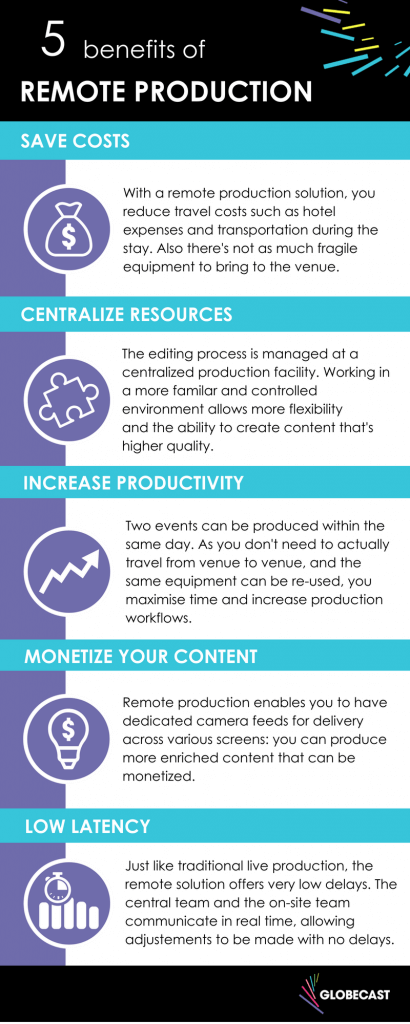Today, the move to IP is a game changer for broadcasters. IP technology enables a more flexible workflow with the ability to instantly transport and share uncompressed 4K live content. As a result, more events are covered by live remotes using IP infrastructure, especially within the live sports sector.
Here are five reasons why remote production might be the solution you need.
It saves on costs
It’s certainly true that that production costs are a major concern for broadcasters and right holders (and to be honest, for everyone nowadays). Remote production is an interesting solution that helps you cut costs, both linked to staff travel and equipment.
With remote production, there’s no need to bring your entire team of producers, managers, editors and other engineers. Fewer people are needed in the field, which lowers travel costs and other related expenses, such as hotel or transportation costs during the stay.
It means you don’t have many associated costs with transporting fragile equipment to the remote site. You can make sure that you use OB trucks to handle higher resolutions when required. But with remote production, you don’t need to rent an OB truck for all the events you cover, allowing you to both save costs and optimize the use of your resources.
It also saves time as the setup of your equipment is consequently faster.
Centralize your production resources
Remote production allows you to bring audio and video streams back to a centralized production studio, allowing for better control and quality during the editing process.
In other words, human and technical resources are available at a central facility, working within their familiar environment, where they can easily control elements such as sound, lighting and power. And this is without being dependent of any weather patterns or other limitations at the remote site. All the material they need is already tested, approved and set up at a centralized studio.
Remote production enables more flexibility and efficiency. But to ensure this, you need to have properly skilled and experienced people in place. People need to communicate and react fast. For instance, when a producer asks his cameramen at the remote site to do something, it should happen with no delay.
Increase your production workflow
Remote production helps you maximize your production workflow. Indeed, while your production costs decrease, your productivity is enhanced.
With traditional OB production you send most of your resources to the site. This means your staff are focused on covering only that particular live production. Then those staff have to return before they can start work on the next production.
With remote production the formula is simple: it allows you to handle multiple events at once. As the production system will be re-used for the next event, your production staff can manage two different productions during the same day.
Monetize your content
Remote production satisfies the requirement to find solutions to the evolving ways of content consumption. Viewers want more content and for more of it to be available on a variety of platforms. Whether on a television, smartphone, computer or tablet, audiences crave for a complete viewing experience.
Marc Logez, Head of Marketing Global Contribution at Globecast, writes, “This model also presents the opportunity to have dedicated camera feeds for delivery to tablets, mobiles, etc…This, in turn, offers an opportunity for these to be monetized. So really, when it comes down to it, remote production provides an economic benefit for rights holders.”
All this with minimum latency!
Finally, it demonstrates the benefits of IP technology to provide high-speed and quality media transport. Indeed, multiple camera and audio feeds can be transported to the centralized production facility with very low latency over long distances.
Marc Logez, adds, “We now have the technology to allow this low latency and enable the director to ask the crew at the stadium to zoom or make any adjustments that are needed, just as it happens in the traditional live production environment. We can then push this further as the technology evolves”.
When does it make sense to choose remote production? Cost will of course be a key determining factor in answering that question. For instance, if you don’t have enough bandwidth, the benefits of remote production might be overtaken by the cost of buying more bandwidth.
Nonetheless, remote production is an efficient, secure and proven solution that allows you to spend less money while better allocating your resources, increasing your production output, and also generating greater revenue.


